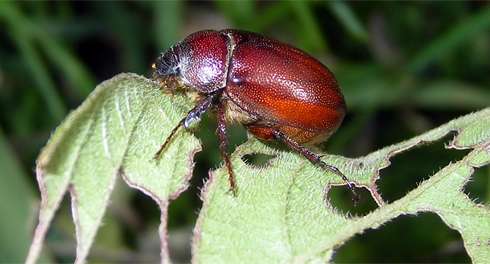Flowering plants revolutionised life on Earth

New evidence from liverworts and beetles shows how the rise of flowering plants 100 million years ago created ideal conditions for a boom in terrestrial life.
Both beetles and liverworts (small moss-like plants) increased in species diversity in response to new ecosystems created by flowering plants, according to two new studies published this week co-authored by Museum scientists.
The studies support the idea of a 'Cretaceous Terrestrial Revolution', a substantial transformation of land-based ecosystems.
The success and spread of flowering plants around 100 million years ago caused terrestrial biodiversity to overtake marine biodiversity for the first time in Earth's history.
Ideal forests
Plants with flowers and fruits, such as broadleaf trees and grasses, are known as angiosperms.
They started small but experienced a great diversification during the Cretaceous, eventually replacing forests dominated by gymnosperms, seed-producing plants such as conifers and cycads.
The humid, tropical forests this explosion created gave the small liverwort plants an ideal habitat in which to flourish. Epiphytic liverworts, those that live on the leaves and trunks of other plants, took particular advantage of the new forests and expanded their range of habitats.
'The rise of the angiosperms expanded the range of possible habitat types and niche species, and thus promoted the increase in species diversity of these plants,' said Museum botanist Dr Harald Schneider.
Trendy new diets
Beetles also diversified their diets alongside the rise of angiosperms. A new study of fossil and molecular information revealed that ancestors to the scarab family of beetles, which include stag beetles, chafers and dung beetles, started to feed on plants shortly after angiosperms first evolved.
'[Early] angiosperms were probably small things that didn't provide many ecological opportunities, but this changed around 100 million years ago when the angiosperms became bigger and tastier,' said Museum expert Prof Alfried Vogler.
Bigger leaves with new chemical components led to an increase in plant-eating beetle species, and other changes in angiosperms led to more new diets. When flowers increased in size and number, beetle species evolved to feed on them.
Mammal poo beats dinosaur poo
Dung-feeding beetles also appear to have evolved as a result of the angiosperm boom. The availability of large leaves spurred a rise in herbivorous mammals.
Dung beetles in turn evolved to feed on the mammals' waste, since mammal dung is more nutritious than the leaf litter used by their ancestors.
It had previously been suggested that dung beetles initially fed on dinosaur poo, but no dung beetle species today feed on bird or reptile poo. Instead, it appears they needed nutritious mammal dung to tempt them into a new diet.
More information:
— Read an abstract of the beetle paper online
— Read the full liverworts paper online
Provided by Natural History Museum

















